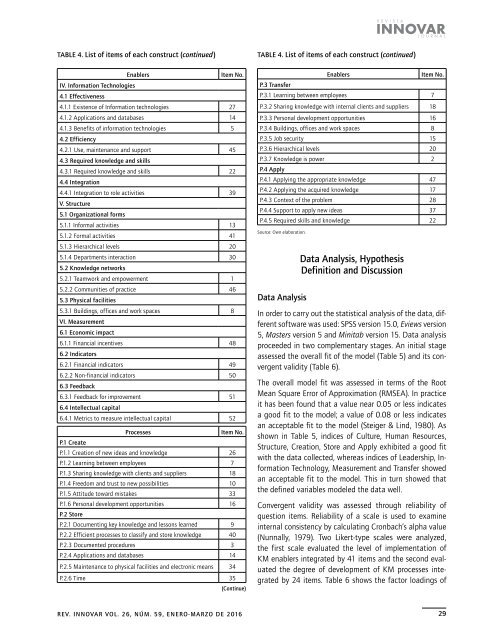Enero-marzo
v26n59
v26n59
You also want an ePaper? Increase the reach of your titles
YUMPU automatically turns print PDFs into web optimized ePapers that Google loves.
REVISTA<br />
INNOVAR<br />
JOURNAL<br />
TABLE 4. List of items of each construct (continued)<br />
Enablers<br />
Item No.<br />
IV. Information Technologies<br />
4.1 Effectiveness<br />
4.1.1 Existence of Information technologies 27<br />
4.1.2 Applications and databases 14<br />
4.1.3 Benefits of information technologies 5<br />
4.2 Efficiency<br />
4.2.1 Use, maintenance and support 45<br />
4.3 Required knowledge and skills<br />
4.3.1 Required knowledge and skills 22<br />
4.4 Integration<br />
4.4.1 Integration to role activities 39<br />
V. Structure<br />
5.1 Organizational forms<br />
5.1.1 Informal activities 13<br />
5.1.2 Formal activities 41<br />
5.1.3 Hierarchical levels 20<br />
5.1.4 Departments interaction 30<br />
5.2 Knowledge networks<br />
5.2.1 Teamwork and empowerment 1<br />
5.2.2 Communities of practice 46<br />
5.3 Physical facilities<br />
5.3.1 Buildings, offices and work spaces 8<br />
VI. Measurement<br />
6.1 Economic impact<br />
6.1.1 Financial incentives 48<br />
6.2 Indicators<br />
6.2.1 Financial indicators 49<br />
6.2.2 Non-financial indicators 50<br />
6.3 Feedback<br />
6.3.1 Feedback for improvement 51<br />
6.4 Intellectual capital<br />
6.4.1 Metrics to measure intellectual capital 52<br />
Processes<br />
Item No.<br />
P.1 Create<br />
P.1.1 Creation of new ideas and knowledge 26<br />
P.1.2 Learning between employees 7<br />
P.1.3 Sharing knowledge with clients and suppliers 18<br />
P.1.4 Freedom and trust to new possibilities 10<br />
P.1.5 Attitude toward mistakes 33<br />
P.1.6 Personal development opportunities 16<br />
P.2 Store<br />
P.2.1 Documenting key knowledge and lessons learned 9<br />
P.2.2 Efficient processes to classify and store knowledge 40<br />
P.2.3 Documented procedures 3<br />
P.2.4 Applications and databases 14<br />
P.2.5 Maintenance to physical facilities and electronic means 34<br />
P.2.6 Time 35<br />
(Continue)<br />
TABLE 4. List of items of each construct (continued)<br />
P.3 Transfer<br />
Enablers<br />
Item No.<br />
P.3.1 Learning between employees 7<br />
P.3.2 Sharing knowledge with internal clients and suppliers 18<br />
P.3.3 Personal development opportunities 16<br />
P.3.4 Buildings, offices and work spaces 8<br />
P.3.5 Job security 15<br />
P.3.6 Hierarchical levels 20<br />
P.3.7 Knowledge is power 2<br />
P.4 Apply<br />
P.4.1 Applying the appropriate knowledge 47<br />
P.4.2 Applying the acquired knowledge 17<br />
P.4.3 Context of the problem 28<br />
P.4.4 Support to apply new ideas 37<br />
P.4.5 Required skills and knowledge 22<br />
Source: Own elaboration.<br />
Data Analysis<br />
Data Analysis, Hypothesis<br />
Definition and Discussion<br />
In order to carry out the statistical analysis of the data, different<br />
software was used: SPSS version 15.0, Eviews version<br />
5, Masters version 5 and Minitab version 15. Data analysis<br />
proceeded in two complementary stages. An initial stage<br />
assessed the overall fit of the model (Table 5) and its convergent<br />
validity (Table 6).<br />
The overall model fit was assessed in terms of the Root<br />
Mean Square Error of Approximation (RMSEA). In practice<br />
it has been found that a value near 0.05 or less indicates<br />
a good fit to the model; a value of 0.08 or less indicates<br />
an acceptable fit to the model (Steiger & Lind, 1980). As<br />
shown in Table 5, indices of Culture, Human Resources,<br />
Structure, Creation, Store and Apply exhibited a good fit<br />
with the data collected, whereas indices of Leadership, Information<br />
Technology, Measurement and Transfer showed<br />
an acceptable fit to the model. This in turn showed that<br />
the defined variables modeled the data well.<br />
Convergent validity was assessed through reliability of<br />
question items. Reliability of a scale is used to examine<br />
internal consistency by calculating Cronbach’s alpha value<br />
(Nunnally, 1979). Two Likert-type scales were analyzed,<br />
the first scale evaluated the level of implementation of<br />
KM enablers integrated by 41 items and the second evaluated<br />
the degree of development of KM processes integrated<br />
by 24 items. Table 6 shows the factor loadings of<br />
REV. INNOVAR VOL. 26, NÚM. 59, ENERO-MARZO DE 2016<br />
29


